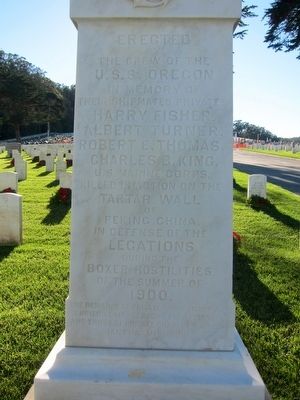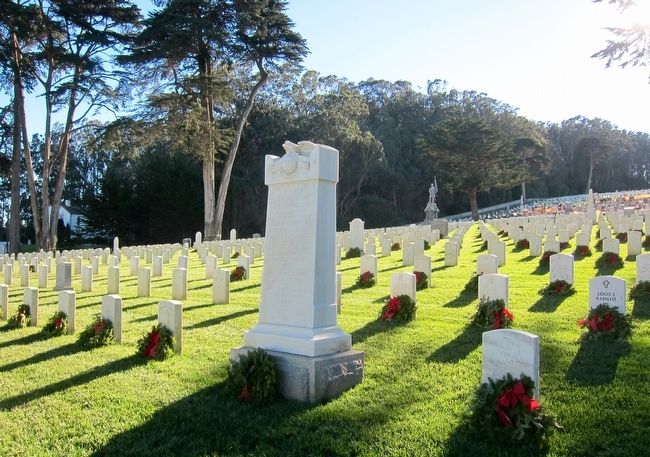Presidio of San Francisco in San Francisco City and County, California — The American West (Pacific Coastal)
U.S.S. Oregon Marine Corps Memorial
by
the crew of the
U.S.S. Oregon
In memory of
their shipmate privates
Harry Fisher,
Albert Turner,
Robert E. Thomas,
Charles B. King,
U.S. Marine Corps
killed in action on the
Tartar Wall
of
Peking, China,
in defense of the
Legations
during the
Boxer Hostilities
of the summer of
1900.
Erected by Crew of the U.S.S. Oregon.
Topics and series. This memorial is listed in this topic list: Military. In addition, it is included in the National Cemeteries series list. A significant historical year for this entry is 1900.
Location. 37° 48.043′ N, 122° 27.768′ W. Marker is in San Francisco, California, in San Francisco City and County. It is in Presidio of San Francisco. Memorial can be reached from the intersection of Lincoln Boulevard and Sheridan Avenue. Touch for map. Marker is at or near this postal address: 1 Lincoln Boulevard, San Francisco CA 94129, United States of America. Touch for directions.
Other nearby markers. At least 8 other markers are within walking distance of this marker. San Francisco National Cemetery (about 300 feet away, measured in a direct line); Post Chapel (about 600 feet away); Sergeants' Row (about 600 feet away); Sutler's Quarters (about 800 feet away); Laundresses' Row (about 800 feet away); Military Intelligence Service Language School (approx. 0.2 miles away); Montgomery Street Barracks (approx. 0.2 miles away); Infantry Row (approx. 0.2 miles away). Touch for a list and map of all markers in San Francisco.
More about this memorial. The memorial is located within San Francisco National Cemetery (in the Presidio, right where Sheridan Avenue turns into Lincoln Boulevard). The memorial is fairly easy to find, as upon entrance one need only go uphill and look for the first larger-than-the-others memorial on the left side of road. Failing that, the cemetery office has a grave locator in front of it. But that shouldn't be necessary, as it stands out pretty well.
Also see . . .
1. The Boxer Rebellion and the Siege of the Foreign Legations, Peking, China, Summer 1900. US Marine Corps Historical Company describes the Siege of the Foreign Legations in 1900: "...For much of the 19th
Century China suffered a series of humiliating defeats at the hands of foreign powers and as a result a great deal of authority now rested in the hands of foreigners. Resentment among the Chinese ran high, with riots and the massacre of foreigners and Chinese Christians becoming commonplace. The Manchu dynasty was tottering and near collapse, with the Dowager Empress and the Imperial Government refusing to take action, secretly siding with the anti-foreign elements. By the end of the 19th Century the most visible and best remembered of these was the Righteous Fists of Harmony, commonly known as the Boxers....By May 1900 conditions were desperate enough that the various Foreign Legations requested the Imperial Government's permission to increase the size of their guard detachments. The Imperial Government refused. The foreign governments then called upon their naval forces in the Far East for protection....On May 24, 1900, Capt. John "Handsome Jack" Myers of the U.S.S Oregon, with 28 Marines and 5 bluejackets, landed at Taku with orders to establish a guard at the United States legation.... (Submitted on December 28, 2015.)
2. U.S. Marines in the Boxer Rebellion - Prologue Magazine (Winter 1999, Vol. 31, No. 4). On June 20, Boxers and Chinese soldiers began a siege of the city....Chinese artillery and small arms fire became constant. There were no organized attacks against the legations. On the twenty- fifth, marines took a critical position on the Tartar Wall. Since the beginning of the siege, Chinese forces had constructed barricades some distance from the front of the marines.... On July 2, Chinese forces managed to advance their barricades dangerously close to the marines' position on the wall; the closest barricade became an immediate threat. Starting around two o'clock the next morning, Captain Myers led U.S. Marines and British and Russian troops in a charge on the Chinese barricade. The attack, carried out during a rainstorm, was successful; the Chinese fell back to another barricade hundreds of yards to the rear. Two marine privates were killed, and Myers was wounded in the leg. The marines resumed their position on the wall, and the daily artillery blasts and sniper fire from Chinese small arms continued as before....Captain Hall took command of the Legation Guard after Captain Myers was wounded. Sniper and artillery fire died down to a minimum after an informal truce was made on the sixteenth. This activity continued until the foreign legations were relieved on August 14. (Submitted on December 28, 2015.)
3. Private Harry Fisher's True Identity - Prologue Magazine (Winter 1999, Vol. 31, No. 4). The Harry Fisher identified on the marker was both a Medal of Honor winner and a deserter. Prologue provides the explanation: "Pvt. Harry Fisher was the first marine to be awarded the Medal of Honor posthumously "for distinguished conduct in the presence of the enemy at the Battle of Peking, China, June 20th to July 16, 1900." Fisher was killed on July 16 while assisting to erect a barricade under heavy enemy fire. Fisher enlisted in the U.S. Marine Corps for five years on May 19, 1899 at Marine Barracks, Washington, D.C. According to his enlistment paper, Fisher was a brakeman from Pennsylvania with no prior military service. In reality, this individual did have prior military service. Harry Fisher turned out to be an alias used by Franklin J. Phillips, a former private in Company M, First U.S. Infantry. During his second enlistment in the U.S. Army, he deserted from Camp A. G. Forse in Huntsville, Alabama, on December 17, 1898. Phillips had caught malaria while serving in Cuba and left his unit to go home for treatment after being refused a sick furlough...." Attempting to rejoin his unit after he recuperated, he was instead dishonorably discharged because of his desertion. Two months later he then enlisted with the USMC under the alias "Harry Fisher". (Submitted on December 28, 2015.)
Credits. This page was last revised on February 7, 2023. It was originally submitted on December 28, 2015, by Andrew Ruppenstein of Lamorinda, California. This page has been viewed 444 times since then and 38 times this year. Photos: 1, 2. submitted on December 28, 2015, by Andrew Ruppenstein of Lamorinda, California.

